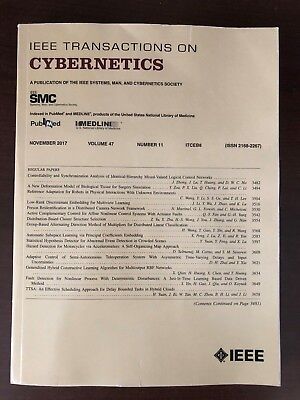SDO-Based Command Filtered Adaptive Neural Tracking Control for MIMO Nonlinear Systems With Time-Varying Constraints
IF 10.5
1区 计算机科学
Q1 AUTOMATION & CONTROL SYSTEMS
引用次数: 0
Abstract
In this article, an adaptive neural tracking control based on saturation disturbance observer (SDO) and command filter is studied for multiple-input–multiple-output nonlinear systems with time-varying constraints and system uncertainties. By employing neural networks (NNs), the system uncertainties are approximated. The SDO is proposed to estimate the composited disturbances which consist of NN approximation errors and the external bounded disturbances. Compared with the traditional disturbance observer, the SDO can reduce the estimation error to some extent. The control requirements are achieved based on the multiconstraints which contain three layers: 1) prescribed performance functions (PPFs); 2) actual constraints; and 3) virtual constraints. The errors remain within the prescribed small neighborhood of zero by using the PPFs, the error constraints ensure that the time-varying constraints are never violated even if the PPFs are not available, and the virtual constraints are applied in a new time-varying barrier Lyapunov function (TVBLF) to design virtual controllers and controller to solve the singularity problem of the traditional TVBLF. In addition, the command filter is introduced to solve the problem of “explosion of complexity.” Finally, a numerical simulation verifies the effectiveness of the proposed scheme for a flight control of unmanned aerial vehicle.具有时变约束的MIMO非线性系统基于SDO的命令滤波自适应神经跟踪控制。
针对具有时变约束和系统不确定性的多输入多输出非线性系统,研究了一种基于饱和扰动观测器和命令滤波器的自适应神经跟踪控制。利用神经网络对系统的不确定性进行近似。SDO用于估计由NN近似误差和外部有界扰动组成的复合扰动。与传统的扰动观测器相比,SDO可以在一定程度上降低估计误差。控制要求是基于包含三层的多约束来实现的:1)规定的性能函数;2) 实际约束;以及3)虚拟约束。通过使用PPF,误差保持在规定的零的小邻域内,误差约束确保即使PPF不可用也不会违反时变约束,并将虚拟约束应用于一种新的时变屏障李雅普诺夫函数(TVBLF)中,设计虚拟控制器和控制器来解决传统TVBLF的奇异性问题。此外,为了解决“复杂性爆炸”的问题,引入了命令滤波器。最后,通过数值模拟验证了所提出的无人机飞行控制方案的有效性。
本文章由计算机程序翻译,如有差异,请以英文原文为准。
求助全文
约1分钟内获得全文
求助全文
来源期刊

IEEE Transactions on Cybernetics
COMPUTER SCIENCE, ARTIFICIAL INTELLIGENCE-COMPUTER SCIENCE, CYBERNETICS
CiteScore
25.40
自引率
11.00%
发文量
1869
期刊介绍:
The scope of the IEEE Transactions on Cybernetics includes computational approaches to the field of cybernetics. Specifically, the transactions welcomes papers on communication and control across machines or machine, human, and organizations. The scope includes such areas as computational intelligence, computer vision, neural networks, genetic algorithms, machine learning, fuzzy systems, cognitive systems, decision making, and robotics, to the extent that they contribute to the theme of cybernetics or demonstrate an application of cybernetics principles.
 求助内容:
求助内容: 应助结果提醒方式:
应助结果提醒方式:


